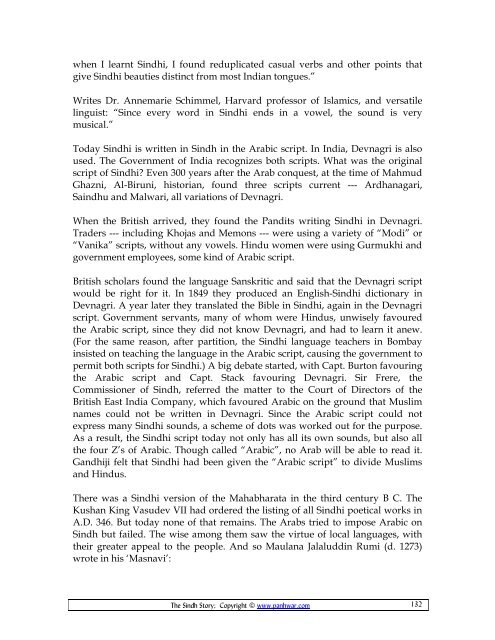Create successful ePaper yourself
Turn your PDF publications into a flip-book with our unique Google optimized e-Paper software.
when I learnt Sindhi, I found reduplicated casual verbs and other points that<br />
give Sindhi beauties distinct from most Indian tongues.”<br />
Writes Dr. Annemarie Schimmel, Harvard professor of Islamics, and versatile<br />
linguist: “Since every word in Sindhi ends in a vowel, the sound is very<br />
musical.”<br />
Today Sindhi is written in Sindh in the Arabic script. In India, Devnagri is also<br />
used. The Government of India recognizes both scripts. What was the original<br />
script of Sindhi? Even 300 years after the Arab conquest, at the time of Mahmud<br />
Ghazni, Al-Biruni, historian, found three scripts current --- Ardhanagari,<br />
Saindhu and Malwari, all variations of Devnagri.<br />
When the British arrived, they found the Pandits writing Sindhi in Devnagri.<br />
Traders --- including Khojas and Memons --- were using a variety of “Modi” or<br />
“Vanika” scripts, without any vowels. Hindu women were using Gurmukhi and<br />
government employees, some kind of Arabic script.<br />
British scholars found the language Sanskritic and said that the Devnagri script<br />
would be right for it. In 1849 they produced an English-Sindhi dictionary in<br />
Devnagri. A year later they translated the Bible in Sindhi, again in the Devnagri<br />
script. Government servants, many of whom were Hindus, unwisely favoured<br />
the Arabic script, since they did not know Devnagri, and had to learn it anew.<br />
(For the same reason, after partition, the Sindhi language teachers in Bombay<br />
insisted on teaching the language in the Arabic script, causing the government to<br />
permit both scripts for Sindhi.) A big debate started, with Capt. Burton favouring<br />
the Arabic script and Capt. Stack favouring Devnagri. Sir Frere, the<br />
Commissioner of Sindh, referred the matter to the Court of Directors of the<br />
British East India Company, which favoured Arabic on the ground that Muslim<br />
names could not be written in Devnagri. Since the Arabic script could not<br />
express many Sindhi sounds, a scheme of dots was worked out for the purpose.<br />
As a result, the Sindhi script today not only has all its own sounds, but also all<br />
the four Z’s of Arabic. Though called “Arabic”, no Arab will be able to read it.<br />
Gandhiji felt that Sindhi had been given the “Arabic script” to divide Muslims<br />
and Hindus.<br />
There was a Sindhi version of the Mahabharata in the third century B C. The<br />
Kushan King Vasudev VII had ordered the listing of all Sindhi poetical works in<br />
A.D. 346. But today none of that remains. The Arabs tried to impose Arabic on<br />
Sindh but failed. The wise among them saw the virtue of local languages, with<br />
their greater appeal to the people. And so Maulana Jalaluddin Rumi (d. 1273)<br />
wrote in his ‘Masnavi’:<br />
The Sindh Story; Copyright © www.panhwar.com<br />
132


